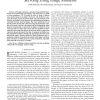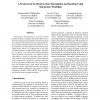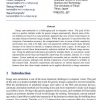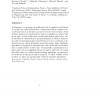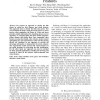116
Voted
TROB
2010
14 years 7 months ago
2010
This paper presents a visual-servoing method that is based on 2-D ultrasound (US) images. The main goal is to guide a robot actuating a 2-D US probe in order to reach a desired cro...
109
Voted
TIP
2010
14 years 7 months ago
2010
A purely bottom-up model of visual attention is proposed and compared to five state-of-the-art models. The role of the low-level visual features is examined in two contexts. Two da...
106
Voted
JUCS
2011
14 years 7 months ago
2011
: This paper describes a new approach to document classification based on visual features alone. Text-based retrieval systems perform poorly on noisy text. We have conducted serie...
122
Voted
COGCOM
2011
14 years 7 months ago
2011
Where does one attend when viewing dynamic scenes? Research into the factors influencing gaze location during static scene viewing have reported that low-level visual features con...
150
Voted
ICPR
2010
IEEE
14 years 10 months ago
2010
IEEE
Hand gesture interpretation is an open research problem in Human Computer Interaction (HCI), which involves locating gesture boundaries (Gesture Spotting) in a continuous video se...
118
Voted
EACL
2009
ACL Anthology
2009
ACL Anthology
Who is "You"? Combining Linguistic and Gaze Features to Resolve Second-Person References in Dialogue
14 years 10 months ago
We explore the problem of resolving the second person English pronoun you in multi-party dialogue, using a combination of linguistic and visual features. First, we distinguish gen...
114
Voted
BMVC
2010
14 years 11 months ago
2010
Image auto-annotation is a challenging task in computer vision. The goal of this task is to predict multiple words for generic images automatically. Recent state-of-theart methods...
120
Voted
AR
1998
15 years 17 days ago
1998
In this paper, we propose an architecture for a cognitive robot based on tactile and visual information. Visual information contains various features such as location and area of ...
141
Voted
JAIR
2007
15 years 23 days ago
2007
In this paper we present a general, flexible framework for learning mappings from images to actions by interacting with the environment. The basic idea is to introduce a feature-...
93
Voted
JMM2
2008
15 years 25 days ago
2008
We propose an approach to classify the film classes by using low level features and visual features. This approach aims to classify the films into genres. Our current domain of stu...
